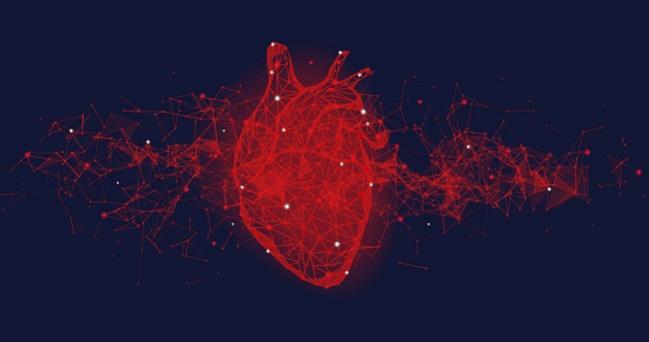Microvascular Thrombi Common in Patients Dying of COVID-19
Like others before, two new studies suggest that myocarditis is rare but microclots are not, supporting a role for anticoagulation.

Two new pathology studies are highlighting the prevalence of microvascular thrombi in the hearts of patients with COVID-19 and exploring the role they might play in causing acute ischemic injury.
In the first, which was led by Giulio Guagliumi, MD (Ospedale Papa Giovanni XXIII, Bergamo, Italy), and senior investigator Aloke Finn, MD (CVPath Institute, Gaithersburg, MD), more than one-third of patients who died of COVID-19 had evidence of cardiac injury, predominantly focal myocyte necrosis, the cause of which they attribute to microthrombi present in the myocardial capillaries, arterioles, and small muscular arteries.

Of the 40 hearts included as part the pathology study, none had evidence of myocarditis as defined by the European Society of Cardiology, but myocyte necrosis was present in 14 cases. Just three patients had evidence of an acute MI, with the remaining 11 patients having focal myocyte necrosis defined as ≥ 0.05 mm2 and less < 1.0 cm2.
“It’s well-known that in hospitalized patients with COVID-19, those with cardiac injury, as indicated by troponin elevation or wall motion abnormalities, certainly do worse from a mortality standpoint than those without cardiac injury,” Finn told TCTMD. Finn was the senior author on a review examining the incidence of myocarditis in COVID-19 that was published last week. “It’s not well understood what’s the predominant cause of the cardiac injury,” he continued. “Is it epicardial coronary thrombosis? Is it myocarditis? Is it microthrombi? It’s not been reported yet in a systematic way. We wanted to pin down, from a pathologic point of view, what was causing the injury.”
In the second study, which was led by Melanie Bois, MD, and senior investigator Joseph Maleszewski, MD (both Mayo Clinic, Rochester, MN), microvascular thrombi were identified in 12 of 15 COVID-19 autopsy cases, including one person who’d had a confirmed infection then subsequently tested negative prior to death. Unlike what was seen in Guagliumi et al’s study, the presence of acute ischemic injury wasn’t as universal in the series by Bois and colleagues, although acute ischemic changes were seen in two patients.
‘Beginning of the Pandemic’
Last summer, Finn, Guagliumi, and others published a case report of a 43-year-old woman who presented with STEMI symptoms in the absence of obstructive coronary disease. Upon her death, an autopsy revealed microvascular thrombi in the inferior wall of the left and right ventricles as the initial cause of the STEMI. The pathologic cause of death was deemed cardiogenic shock due to myocardial necrosis, which was extensive and which the researchers said likely occurred because of the poor perfusion of the heart.
We wanted to pin down, from a pathologic point of view, what was causing the injury. Aloke Finn
In their new study, published online January 22, 2021, in Circulation, Guagliumi and Finn cast a wider net to understand just how prevalent cardiac injury in hospitalized COVID-19 patients might be and the major causes of that injury. In total, researchers included 40 unselected patients undergoing autopsy who died during the first wave of the pandemic in Bergamo, Italy. The hearts of all patients were sent to the CVPath Institute for pathological analysis.
“At that time, at the beginning of the pandemic, people really didn’t have a good idea of what tests we should be doing, or what we should be looking at,” said Finn. “It turns out troponins weren’t available for every single patient, so we didn’t go by troponin levels as an indicator of myocardial injury. We had to go by a pathologic indicator of injury, and that was myocyte necrosis. About 35% of the cases had myocyte necrosis, which is consistent with the injury others have seen in clinical studies.”
For the 14 cases with cardiac injury, three individuals (21.4%) had evidence of an acute MI, defined as having myocyte necrosis ≥ 1.0 cm2. On the other hand, focal myocyte necrosis, which Finn described as small, spotty areas of infarction, was evident in the remainder of those with cardiac injury.
Among the patients with myocardial necrosis, two had evidence of epicardial coronary thrombosis in the setting of severe coronary atherosclerosis. Another four people showed evidence of right ventricular strain documented with right ventricular necrosis. Of the 11 cases with focal myocyte necrosis, eight had evidence of microthrombi (observed in just a single patient with acute MI). The distribution pattern of microthrombi typically matched the distribution pattern of focal myocyte necrosis.
“In most of these cases, we can’t say the damage was extensive and ended up being the demise of the patient,” said Finn. “That’s not the case. But it’s still causing damage to the heart.”
The researchers also analyzed whether the virus was found within the endothelial cells of the autopsied hearts, given previous reports that it might be responsible for the cardiac injury. However, they were unable to find the virus within the hearts they examined, suggesting that endothelial infection is “likely not a major mechanism of cardiac microthrombi formation in subjects with COVID-19 infection.”
They did find that the cardiac microthrombi differed in composition from the intramyocardial thromboemboli captured from patients with COVID-19, as well as aspirated thrombi collected during PCI of COVID-19 cases and non-COVID-19 cases. In this setting, the microthrombi obtained in the capillaries, arterioles, and small arteries contained more fibrin and C5b-9, which is part of the complement cascade.
To TCTMD, Finn said the long-term consequences of myocyte necrosis in patients who survive COVID-19 are a major unknown. Anticoagulation to prevent its onset is one possibility, he said, highlighting the emerging evidence from clinical trials testing anticoagulation. The differing constituents of microthrombi they identified in their analysis, however, raise the question of whether traditional anticoagulants or antiplatelets would be effective for the preventing such cardiac injury, or even thromboembolic events. He also pointed out there is no clinical test for identifying patients with microvascular thrombi who might be at risk for myocyte necrosis.
“We can get this from pathology, but we can’t make this diagnosis when people are alive,” said Finn. “It’s another problematic aspect.”
Comparing COVID-19 Deaths
In the second study, also published in Circulation, investigators also performed a cardiac evaluation during the postmortem evaluation of 15 COVID-19 cases, including three patients who were cleared of SARS-CoV-2 prior to death. They compared the findings with the hearts of six patients who died of influenza A/B or from nonviral causes (control group).
Overall, fibrin microthrombi were identified in 16 cases, including 12 people with COVID-19 (one cleared), two with influenza, and two controls. Five of the hearts of COVID-19 patients, including one cleared of the virus, had evidence of myocarditis. The case with the cleared infection had extensive myocardial involvement with fibrosis and focal active myocyte injury, but the others only had evidence of focal active myocyte injury.
We need to make sure that what we’re identifying by imaging corroborates what we’re seeing under the microscope. And in fact, it does not. Joseph Maleszewski
To TCTMD, Maleszewski said the study by Guagliumi et al corroborates their finding that microvascular thrombi are frequently encountered in the setting of COVID-19. With respect to the constituency of the microthrombi, particularly the identification of C5b-9 seen by Finn and the Italian researchers, Maleszewski explained that it’s likely the result of the body’s inflammatory response.
“More specifically, [it’s an] antibody-antigen interaction, which then serves to activate the complement cascade, which can then result in coagulation,” he said. This is likely caused, at least in part, by a systemic inflammatory response, although he cautioned that this is not definitive. “It’s suggestive of a story that we’re all still trying to unravel,” said Maleszewski.
He also noted that evidence of cardiac injury was more frequently observed in that study by Guagliumi et al, although those researchers used a broader definition of myocyte injury than the Mayo group.
“The next interesting question is whether these little thrombi are responsible for the infarction events we’re seeing here,” he said. “The implication in their work is yes, sure, they are, and I think that’s probably at least part of the story, although I don’t know if it’s the entire story as these patients all have some pretty significant confounding variables.” For example, nearly three-quarters of the 40 COVID-19 cases had evidence of hypertrophy, he said. Additionally, on the supply side, most of the patients had acute respiratory distress syndrome, which could contribute to microfocal myocyte injury irrespective of microthrombus.
As for potential treatment, Maleszewski took a glass-half-full approach, particularly given that researchers are starting to now identify the constituency of these microvascular thrombi. Doing so might allow researchers to “pinpoint our medical arsenal at the potential problem in a more regimented and much more deliberate way,” he said.
Question of Myocarditis
The Italian/US researchers observed no evidence of myocarditis in the 40 hearts examined, and although Bois and Maleszewski documented myocarditis in one-third of patients with active and cleared COVID-19 cases, it was limited despite extensive myocardium sampling, they say.
These findings support those of Finn and colleagues’ review last week that aimed to provide reassurance. It concluded that myocarditis is actually quite rare in patients with COVID-19, as reported by TCTMD.
Maleszewski said that review was encouraging and that it challenges some of the earlier hypotheses that myocarditis might be a significant contributor to myocardial injury in COVID-19. Those earliest concerns stemmed from imaging findings, but the gold standard for identifying myocarditis remains a biopsy, he said.
“We need to make sure that what we’re identifying by imaging corroborates what we’re seeing under the microscope,” said Maleszewski. “And in fact, it does not. It’s an important reminder for us all to be careful about how definitely we speak about these things.” The COVID-19 pandemic also reinforces the importance of autopsies, which have been declining in the US for decades, he said. “It informs us, if we’re scientific about it, [about] where some important misconceptions might be, like the myocarditis issue.”
Michael O’Riordan is the Managing Editor for TCTMD. He completed his undergraduate degrees at Queen’s University in Kingston, ON, and…
Read Full BioSources
Pellegrini D, Kawakami R, Guagliumi G, et al. Microthrombi as a major cause of cardiac injury in COVID-19: a pathologic study. Circulation. 2021;Epub ahead of print.
Bois MC, Boire NA, Layman AJ, et al. COVID-19-associated nonocclusive fibrin microthrombi in the heart. Circulation. 2021;Epub ahead of print.
Disclosures
- Finn reports honoraria from Abbott Vascular, Biosensors, Boston Scientific, CeloNova, Cook Medical, CSI, Lutonix Bard, Sinomed, and Terumo Corporation. He reports consulting to Amgen, Abbott Vascular, Boston Scientific, CeloNova, Cook Medical, Lutonix Bard, and Sinomed.
- Maleszewski reports no relevant conflicts of interest.





Comments